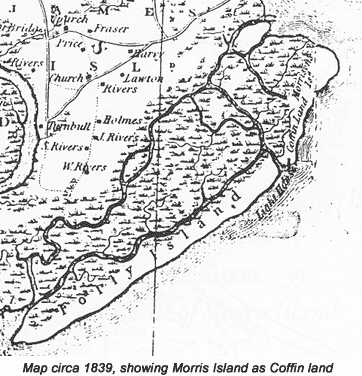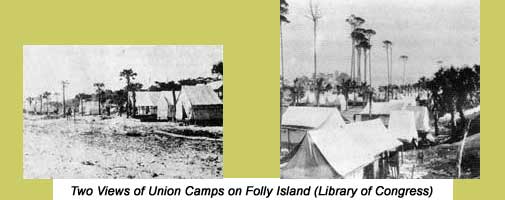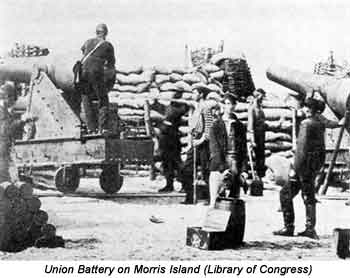|
.....Much
of what we know concerning the history of Folly Beach comes from its
close geographic and cultural connections to the city of Charleston,
South Carolina. The name "folly" is thought to have come from
the Old English translation of the word, which means a clump of trees
or a thicket. This name appears historically appropriate for the island.
The main shipping channel into Charleston harbor in the 1700 and 1800's
brought the ships past the northern side of Folly Island. For some ships,
the trees on Folly Island may have been the first they had seen after
a long voyage across the Atlantic. The island is also at times labeled
Coffin Land or Coffin Island on some historical maps.

(Click on the map for higher
resolution)
.....The
significance of this name is still under debate for several reasons.
Some believe that it is due to the fact that ships entering Charleston
harbor would drop off sick and dying people on the island to avoid becoming
quarantined. Others believe it came about from a shipwreck that occurred
off the coast of Folly in 1700. This lead to many of the bodies of those
onboard washing up on the beach. The final inconsistency with the name
Coffin Island is that documents also show that name being used for Morris
Island as early as 1749.

(Click on the map for higher
resolution)
Morris Island was the
location of the Pest House in 1834. The Pest house was used to house
sick and contagious people entering the port of Charleston. Boats would
have to unload their sick passengers and crew before being allowed safe
passage into the harbor. The large number of sick and dying people on
this island may have lead to its naming. Mislabeling in maps is common
throughout history and occurs all over the world, the Iceland - Greenland
situation is a modern example.
..... Although Folly Island today is a
continuous island stretching from the Stono Inlet to Lighthouse Inlet,
that has not always been the case. Many maps show Folly to have been
considered two islands, commonly known as Big Folly and Little Folly.
Historical records from the time of the Civil War state that travel
from Big Folly, across the neck of the island, today called the washout,
to Little Folly was only possible along the beach at low tide.
.....Folly Island also played an important
historical role during the Civil War. Federal troops began occupying
the island in 1863. At the height of the occupation, over 13,000 troops
were stationed on the island.

The island these troops
occupied was very different from the island of today. At that time,
Folly Island was relatively uninhabited. The first system of roads on
the island was constructed by the federal troops to allow ambulances
to transport wounded soldiers, and for communication purposes.

The troops also constructed various forts
and batteries on both the northern and southern end of the island. A
large commissary depot, known as Pawnee Landing was built to aid in
the unloading of troops and supplies. The only actual fighting to occur
on Folly Island was on May 10th, 1863, when confederate forces attacked
federal pickets on the left side of Little Folly Island. The fighting
was light, as the confederate forces were conducting a reconnaissance
mission, aimed mostly at gathering information and taking prisoners.
.....Folly Island's major importance in
the Civil War was its use as a base, housing troops and equipment, and
for the presence of an artillery battery located at the northern end
of Little Folly. The island was the federal staging area for the battle
of Morris Island which took place from July to September of 1863. Morris
Island was the home of Fort Wagner, a confederate fortification that
guarded the entrance to Charleston harbor. From the artillery battery
on Little Folly, the federal troops shelled Fort Wagner and deployed
troops to capture the fort. With the capture of Fort Wagner, the federal
troops were now in position to shell Fort Sumter. The troops moved their
artillery from Big Folly to the captured fort, and renamed it Battery
Meade.

The shelling began on August 17th, 1863,
and quickly reduced Fort Sumter to rubble, but it was unable to force
a confederate surrender. Folly Island, and Morris Island remained occupied
by federal troops until the end of the war.
|